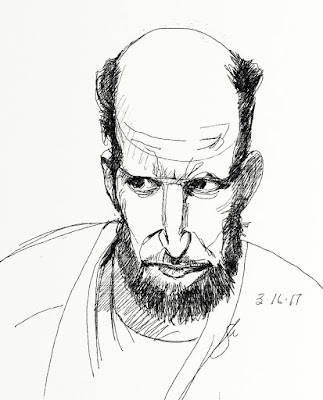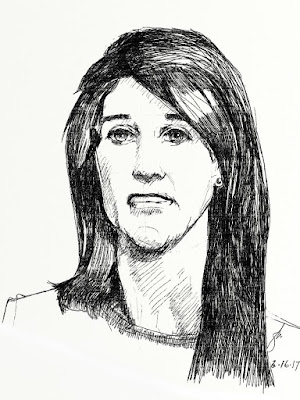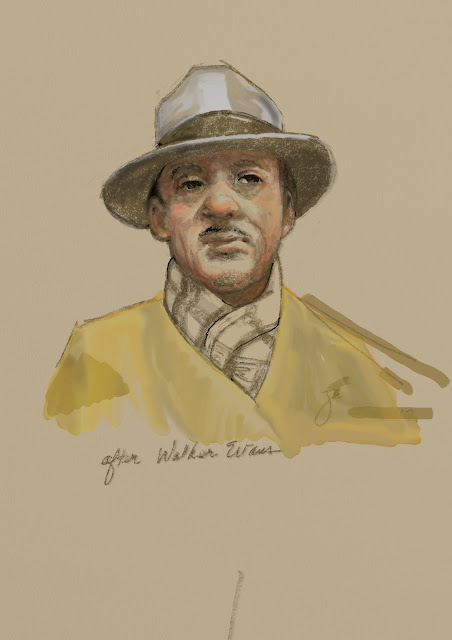Digital art has progressed far from the days of ASCII-based images produced by repeating printed letters to CGI images and computerized movie effects, to completely digital movies. Computer programs for desktop machines and tablets have become very sophisticated. Photoshop, from Adobe, originally released in the 1990s, became the best-known program and has spawned a number of Photoshop spin-offs. Another Adobe program called Illustrator is widely used. And there has been a profusion of new programs and applications during this century. Sketchbook (a product of Autodesk) is a program/app that I've used with pleasure over the past few years both on desktop machines and on a tablet.
One particular program that has been a standout for me since its initial release is
ArtRage, from Ambient Design. Like older versions, the new ArtRage emulates the appearance and production of real-world drawings and paintings. You can make a drawing that looks like graphite or charcoal on paper, or a "painting" that has the appearance of watermedia--whether transparent or opaque--on a variety of textures similar to real world counterparts like canvas or sketching paper. Moreover, ArtRage not only allows you to make a digital image that
resembles traditional ones but also (at least in part) reproduces the
physical qualities of the medium. That is, watercolors can be laid down
transparently in ArtRage, on absorbent "paper"that allows the color to bleed into the
background. Or "oil paint" can be mixed and blended very similarly to
the real tubed counterpart.
The ArtRage interface is simple enough to use, with a toolbar at the top, a set of tools in one corner and a color-picker in the other, although both can be hidden to reduce clutter. Popups for layers, orientation and color samples can be left open constantly or kept closed to reduce clutter. One outstanding feature of ArtRage is a small widget that lets the artist pin a reference image to the computer screen while drawing or painting, just as you would on a traditional drawing board. Another widget, called Tracing, functions the way that a light box and tracing paper did in pre-computer days--you can upload and trace an image for easy transfer.

The newest version, ArtRage5, was released in February, and I've had an opportunity work with a reviewer copy this past month or so. The interface remains the same as in previous releases. As always, you can draw and paint on quite a number of surfaces and textures. The drawing to the right was done from an image I encountered online. The unusual perspective interested me in particular. This was done on an iPad Pro using the Apple Pencil and the ArtRage pencil tool on a simulated paper surface. The image, to my eye, emulates the appearance of actual graphite on paper quite well.

Here is another drawing using a similar digital surface--what the ArtRage interface calls sketch paper. In this case I used a pastel tool and narrowed and expanded its width as needed, with dead black as the selected color. The reference image was another encountered online and modified in the sketch. The drawing has some features that are similar to charcoal or perhaps Conte crayon. In some ways there is a resemblance to ink drawing as well.
Besides traditional surfaces ArtRage lets you choose a wide range of colored and textured backgrounds. The drawing at right is based on an online story about a Bangladesh beauty contest featuring women who had been attacked with acid. Unbelievably there are hundreds of such images online, suggesting that this particular brutality toward women is more common than we think.
This image is posted larger to show the "paper"--the swirly digital surface resembles actual handmade paper. When you draw it seems to catch and darken certain media (graphite, charcoal) the way a real surface might. The idea here was to emulate the dark, twisted ridges of scars on her face. The result was gratifying, if horrible to contemplate.
This is a sort of graphic illustration done on a background of shiny, crumpled gold, part of the ArtRage library of surfaces and backgrounds. The idea for this sprang to mind when I saw the pebbly gold. This particular drawn image is a composite of a number of photo references from various sources, and seemed a natural result of the connection of gilt and glitter to the subject. The tools I used varied from pencil tool to the paintbrush, using color complements of gold, or darker values of the base color. The background was overpainted and blurred to help establish depth.

Besides clearly graphic images like those above, you can produce "paintings" like the one at right. Using only watercolor tools and presets in the program, I made this image based on a photo by the famous Depression-era photographer, Walker Evans. The Evans photograph was of a dapper man on a city subway, shot in black and white. I adapted the image to color using muted colors as a reflection of the original. This was done in two or three layers, the background chosen as a warm yellow-gray. To my eye this looks quite a lot like a gouache or casein painting.
Although I have not tried, it's no doubt possible to make an image to resemble oil paint as well. I one suspect it would take considerably longer and involve several layers.
For me, that remains another challenge.
Nonetheless, ArtRage5 extends the line of useful, versatile, artist-friendly art apps available at a reasonable cost. You can download it for tablets, laptops and desktops from various sources online, including of course the
official ArtRage site.
---
Previous post: Digital Sketching
















